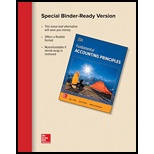
Concept explainers
Concept Introduction:
A liability can be defined as an obligation which a person or a company needs to pay which arises during the course of the business.
A liability can be short term or long term depending upon the time period in which it is required to be paid. If a liability is required to be paid with in a period of 12 months i.e. one year it will be treated as current liability and if a liability is required to be paid beyond a period of 12 months or one operating cycle, it will be treated as long term liability.
To determine:
Difference between a current and long-term liability
Explanation of Solution
A liability can be defined as an obligation which a person or a company needs to pay which arises during the course of the business.
A current liability can be defined as the liability that is required to be paid within a period of 12 months or one operating cycle. Example accounts payable, short term notes payable.
While a long term liability can be defined as the liability that is required to be paid in a period of more than 12 months or one year or one operating cycle. Example – Bonds issued for 5 years, loan taken from bank to be paid in 3 years etc.
The difference between a current and long-term liability can be elaborated as under –
| Basis | Current Liability | Long-term Liability |
| Time period | It is required to be paid with a period of 12 months or one operating cycle of the |
It is required to be paid beyond a period of 12 months or one operating cycle of the balance sheet. |
| Examples | Example are accounts payable, notes payable, wages and salaries, interest, dividends, short term loans etc. | Examples are leases, bonds issued for more than one year, pension obligations, |
| Recording in the balance sheet | Recorded in the balance according to the occurrence of their due dates in the current liability section. | They are recorded in a separate section under the head long-term liabilities in the balance sheet. |
Thus, it can be concluded that, the main difference between current and long term liability is that a current liability is required to be paid within a period of 12 months while, a long term liability is required to be paid beyond a period of 12 months.
Want to see more full solutions like this?
Chapter 11 Solutions
Loose Leaf for Fundamental Accounting Principles
- Please provide the answer to this general accounting question with proper steps.arrow_forwardI am looking for the correct answer to this financial accounting problem using valid accounting standards.arrow_forwardI am looking for the most effective method for solving this financial accounting problem.arrow_forward
- Pugh Sporting Goods manufactures two types of kayaks: River Explorers and Lake Cruisers. The company incurred manufacturing overhead costs of $320,000 in May. They have decided to allocate these costs based on units produced. During May, the company used 10,500 direct labor hours for River Explorers and 12,000 direct labor hours for Lake Cruisers. In total, the company produced 8,000 River Explorers and 6,000 Lake Cruisers. The amount of overhead allocated to each product, respectively, would be: a) $182,880 and $137,160 b) $140,000 and $180,000 c) $160,000 and $160,000 d) $175,000 and $145,000 e) $168,000 and $152,000arrow_forwardWhen do organizational boundaries require special accounting treatment? (a) Standard rules work everywhere (b) Physical locations define all boundaries (c) Virtual operations blur traditional entity definitions d) Boundaries never change.MCQarrow_forwardWhat is the total amount of manufacturing overhead costs for the month of April?arrow_forward
- Please help me solve this general accounting problem with the correct financial process.arrow_forwardCan you help me solve this general accounting question using valid accounting techniques?arrow_forwardPlease provide the accurate answer to this financial accounting problem using appropriate methods.arrow_forward

 AccountingAccountingISBN:9781337272094Author:WARREN, Carl S., Reeve, James M., Duchac, Jonathan E.Publisher:Cengage Learning,
AccountingAccountingISBN:9781337272094Author:WARREN, Carl S., Reeve, James M., Duchac, Jonathan E.Publisher:Cengage Learning, Accounting Information SystemsAccountingISBN:9781337619202Author:Hall, James A.Publisher:Cengage Learning,
Accounting Information SystemsAccountingISBN:9781337619202Author:Hall, James A.Publisher:Cengage Learning, Horngren's Cost Accounting: A Managerial Emphasis...AccountingISBN:9780134475585Author:Srikant M. Datar, Madhav V. RajanPublisher:PEARSON
Horngren's Cost Accounting: A Managerial Emphasis...AccountingISBN:9780134475585Author:Srikant M. Datar, Madhav V. RajanPublisher:PEARSON Intermediate AccountingAccountingISBN:9781259722660Author:J. David Spiceland, Mark W. Nelson, Wayne M ThomasPublisher:McGraw-Hill Education
Intermediate AccountingAccountingISBN:9781259722660Author:J. David Spiceland, Mark W. Nelson, Wayne M ThomasPublisher:McGraw-Hill Education Financial and Managerial AccountingAccountingISBN:9781259726705Author:John J Wild, Ken W. Shaw, Barbara Chiappetta Fundamental Accounting PrinciplesPublisher:McGraw-Hill Education
Financial and Managerial AccountingAccountingISBN:9781259726705Author:John J Wild, Ken W. Shaw, Barbara Chiappetta Fundamental Accounting PrinciplesPublisher:McGraw-Hill Education





